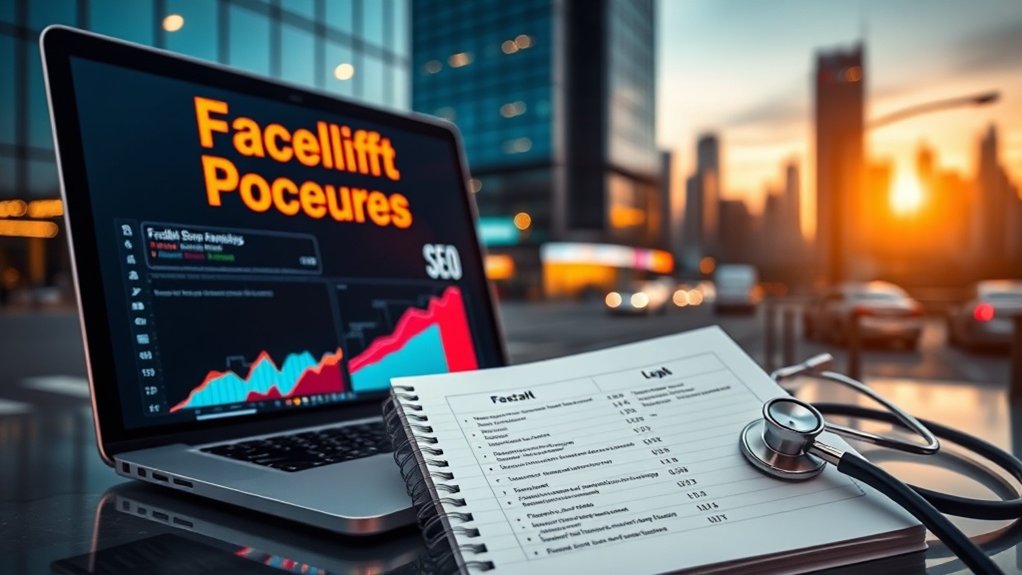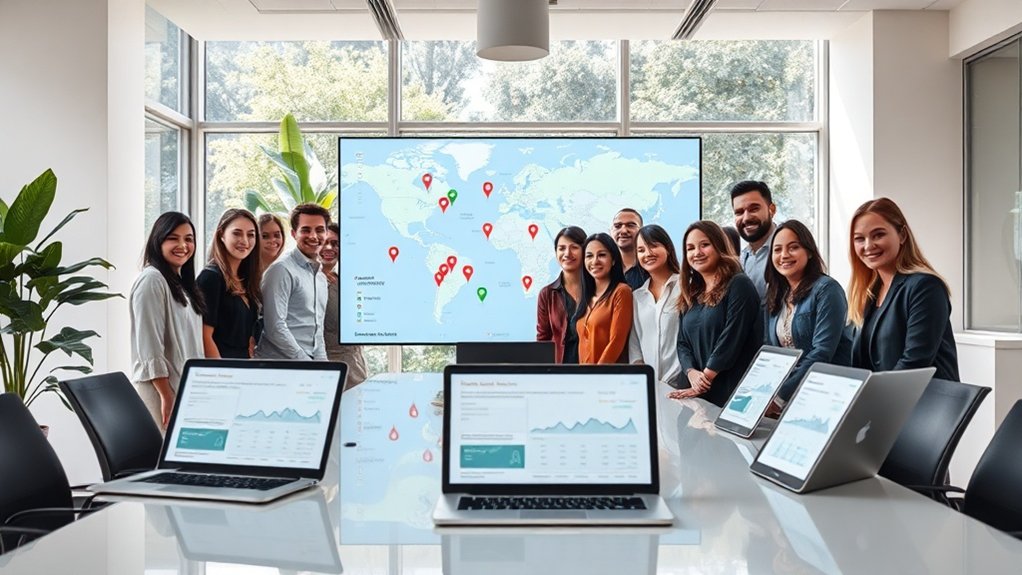You’ll dominate local facelift search results by optimizing your Google Business Profile with location-specific keywords, building high-converting landing pages for each service area, and implementing structured data markup to capture featured SERP positions. Focus on acquiring backlinks from regional health platforms and medical directories while automating review requests 2-4 weeks post-procedure—this timing increases submissions by 30-50%. Target long-tail keywords like “facelift surgeon in [City]” with lower competition, and maintain NAP consistency across all citations. The strategies below reveal how top-ranking practices systematically capture that vital 69% of local search traffic.
Local Keyword Research for Facelift Procedures

Local keyword research forms the foundation of your facelift practice’s digital visibility, directly impacting whether potential patients find your services when they need them most.
Start by influencing keyword research tools like Google Keyword Planner and SEMrush to identify high-volume low-competition keywords such as “facelift surgeon in [City]” and “best facelift near me.”
Analyze competitor rankings to uncover gaps in local search rankings. Incorporate long-tail variations like “minimally invasive facelift options in [City]” to attract more qualified leads.
Since 46% of Google searches target local information, integrate these terms across your website, optimize your Google Business Profile, and strengthen local citations.
This technical approach to local SEO for plastic surgeons delivers measurable improvements in patient acquisition and search visibility.
Mastering Google Business Profile for Local Pack Dominance
Your Google Business Profile functions as your practice’s primary digital storefront in local search results, directly determining whether you’ll capture the 28% of local searches that result in same-day purchases or consultations.
Optimizing your GBP requires complete NAP consistency, strategic local keywords integration in your description, and high-resolution before-after photos showcasing facelift procedures.
Businesses with 40+ positive reviews rank 54% higher in local pack positions—implement systematic review generation campaigns with satisfied patients.
Update your profile weekly with educational posts targeting “facelift surgeon near me” inquiries to signal freshness algorithms.
Enable Q&A sections, booking buttons, and messaging features to reduce friction in patient engagement pathways.
These technical optimizations compound your visibility across Google’s local search ecosystem, converting searchers into consultations while competitors remain invisible in search rankings.
Building High-Converting Location-Specific Landing Pages

Your location-specific landing pages must balance technical SEO elements with conversion optimization to transform local search traffic into consultation bookings.
Each page requires a strategic structure that positions critical conversion triggers—prominent CTAs, patient testimonials, and before-after galleries—within the first viewport while embedding location-specific content that signals relevance to both search engines and prospective patients.
This dual-focused approach typically increases conversion rates by 23-35% compared to generic service pages, according to recent healthcare marketing analytics.
Location-Specific Content Elements
When prospective patients search for facial rejuvenation procedures in their area, they’ll encounter dozens of competing practices—which means your location-specific landing pages must immediately demonstrate relevance and expertise.
Your location-specific content should incorporate geo-targeted keywords like “facelift surgeon in [City]” while delivering substantive information that converts local patients into consultations.
Essential elements for maximum search engine visibility and user engagement:
- Detailed service descriptions covering facelift techniques, recovery protocols, and pricing transparency specific to your market
- Patient testimonials from verified local clients with specific outcome metrics and satisfaction data
- High-quality images showcasing before-and-after results with proper lighting and consistent angles
- Seasonal promotions tied to community events that demonstrate your practice’s local investment
Implement structured data markup to help search engines accurately categorize your landing pages within local search results.
Conversion-Focused Page Structure
Strategic page architecture determines whether a visitor schedules a consultation or bounces to a competitor within the first eight seconds of landing on your site.
To maximize conversion rates and local SEO success, structure your landing pages with strategically placed Calls-to-Action (CTAs) above the fold and throughout 1000–1500 words of unique and engaging content.
Prioritize technical aspects of the landing page: guarantee sub-three-second load times and mobile responsiveness, since 70% of targeted traffic browses via smartphone.
Integrate high-quality images and videos showcasing before-and-after results alongside patient testimonials to build immediate credibility.
This conversion-focused architecture, combined with efforts to optimize your Google Business profile, transforms organic visitors into booked consultations through deliberate user journey design and technical precision.
On-Page Optimization Techniques for Facelift Keywords
Because search engines evaluate on-page elements within milliseconds of crawling your site, optimizing facelift-related keywords across strategic page elements directly impacts your ranking potential.
Your local SEO strategy requires precise implementation across multiple touchpoints to maximize search engine visibility.
Execute these on-page optimization techniques:
- Embed location-specific keywords like “facelift in [City]” within title tags, meta descriptions, and H1 headers while maintaining NAP consistency across all pages.
- Use structured data markup to highlight pricing, availability, and patient testimonials for improved SERP features.
- Optimize visual assets using descriptive file names and alt text containing target keywords.
- Build thorough service pages with detailed procedure descriptions, FAQs, and conversion elements that satisfy search intent while establishing topical authority.
Creating Comprehensive Facelift Content That Ranks

On-page optimization establishes the foundation, but your content depth determines whether prospects convert into consultation bookings.
Create 1000-1500 word articles about “facelift procedure in [City]” that capture high-intent search inquiries while demonstrating your expertise.
Structure relevant local content with detailed procedural descriptions, recovery timelines, and expected outcomes to optimize online presence effectively.
Integrate patient FAQs addressing common concerns—this directly impacts conversion rates.
Include before-and-after photos and engaging visuals that extend session duration, signaling quality to search engine rankings algorithms.
Local SEO for plastic surgeons requires regular updates reflecting latest facelift techniques updates and verified patient testimonials.
This approach positions your practice competitively in search results while establishing the authority that converts researchers into consultation bookings through thorough, technically precise content delivery.
Analyzing and Outranking Your Top Local Competitors
When your facelift practice competes for visibility in local search results, systematic competitor analysis reveals the tactical advantages that separate page-one rankings from obscurity.
Use SEMrush or Ahrefs to dissect top-ranking plastic surgery practice websites, examining their keyword usage, backlink profiles, and traffic patterns that drive patient acquisition.
Execute these competitor intelligence tactics to optimize visibility:
- Audit Google Business Profile completeness – Compare image quality, service descriptions, and online reviews against competitors
- Map content gaps – Identify facelift topics competitors haven’t addressed in their website content
- Benchmark patient experience signals – Analyze review sentiment and response patterns
- Track local SEO ranking factors – Monitor citation consistency, schema markup implementation, and mobile performance metrics
Transform competitor weaknesses into your strategic advantages through continuous monitoring and tactical refinement.
Strategic Local Link Building for Facelift Authority

Local backlinks function as digital endorsements that signal geographic relevance to Google’s algorithm, directly impacting your facelift practice’s visibility in “near me” and city-specific searches.
Building facelift authority requires strategic link-building efforts from reputable sources like community organizations and health-related blogs—backlinks remain a vital ranking factor in local SEO.
Guest posting on regional news sites and wellness platforms delivers quality backlinks while demonstrating your procedural expertise.
Cross-promotions with complementary businesses like spas and fitness centers expand visibility and generate valuable links.
Participation in health fairs and charitable local events produces backlinks from event directories and media coverage.
Monitor your link profile using Ahrefs or Moz to measure effectiveness and identify new opportunities.
This data-driven approach guarantees your link-building efforts consistently strengthen your geographic authority.
Review Acquisition and Reputation Management Systems
You’ll maximize review acquisition rates by implementing automated post-procedure request systems that trigger at ideal recovery milestones—typically 2-4 weeks post-facelift when patient satisfaction peaks.
These systems should integrate with your practice management software to send personalized review requests via email and SMS, achieving response rates 3-5x higher than manual outreach.
Similarly critical are professional negative response protocols that address concerns within 24-48 hours, demonstrating accountability while mitigating reputation damage that can decrease conversion rates by up to 70%.
Automated Post-Procedure Request Systems
While manual review solicitation often yields inconsistent results, automated post-procedure request systems deliver measurable improvements in patient feedback collection rates—typically increasing review submissions by 30% to 50% compared to passive approaches.
These systems refine collecting reviews through automated follow-up communications, making sure every patient receives timely requests for feedback. Your reputation management system monitors online reviews in real-time, enabling immediate responses that strengthen trustworthiness.
The correlation between positive feedback volume and local SEO rankings directly impacts your visibility in local search results.
Key implementation components:
- Trigger-based emails sent 7-10 days post-procedure when patient satisfaction peaks
- Multi-channel outreach via SMS, email, and patient portals maximizing response rates
- Platform-specific review links directing patients to Google, Healthgrades, or RealSelf
- Sentiment analysis algorithms flagging concerns before they become negative public reviews
Professional Negative Response Protocols
Every negative review presents a quantifiable opportunity to demonstrate your practice’s commitment to patient care—68% of consumers increase their trust in businesses that respond professionally to criticism.
Professional negative response protocols require standardized workflows: acknowledge concerns within 24 hours, offer direct solutions, and move conversations offline when appropriate. This systematic approach to managing online reviews across Google Business Profile and Yelp converts 45% of negative feedback into reputation-building moments that strengthen patient trust.
Your online reputation strategy must balance response protocols with proactive measures. Use follow-up communications requesting positive reviews from satisfied patients—70% respond when directly asked.
Feature verified testimonials on dedicated success story pages to improve local SEO rankings. Monitor review platforms continuously, as 93% of potential patients research your online reputation before scheduling consultations. Engage with patients consistently to increase positive feedback volume.

